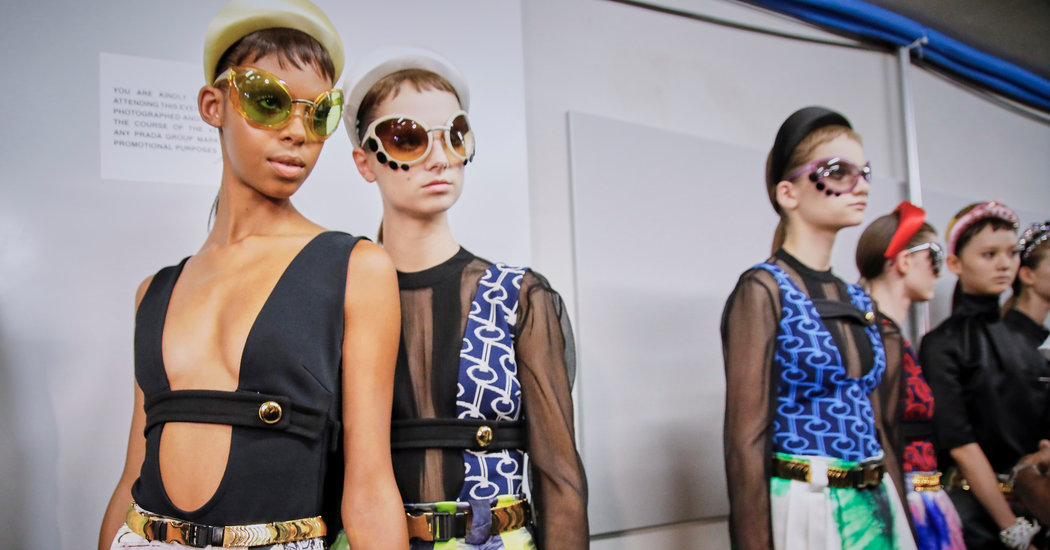
MILAN — Earlier this summer Apple unveiled a new retail concept in Milan: a store beneath a glassed-in cascading fountain in a piazza just around the corner from the Corso Vittorio Emanuele II, the shopping thoroughfare that connects the Duomo and the Piazza San Babila.
That was just a little more than month before Starbucks invaded the historic environs of the city’s former central post office with its first outpost in Italy, a Reserve Roastery. Thus the world turns.
“You can complain about it or you can embrace it,” Jeremy Scott said cheerfully backstage before his Moschino show. “But I don’t think you can slow down progress.” Not even the current too-fast turning of the fashion world, that oft-bemoaned pace of collection after collection (less than two weeks ago Mr. Scott had been at New York Fashion Week showing his own brand, and he’s got an H&M collection looming in just over a month).
“We live in a world of instant information and I don’t see it changing. I know people talk about the Second Coming and tech shutting down, but I can’t imagine that.”
Generally, the default reaction in fashion has been to complain about the pace, or at least to engage in some angst-ridden moaning and fetishization of a slower age, but Mr. Scott had a different idea. What if, instead of dragging your heels, you just accepted it?
What if you dared to imagine a worst-case scenario caused by the current shift — you know, the scenario that keeps you up at night, the one so bad you don’t even want to voice it aloud. The one where you didn’t have time to actually finish a collection, and all you had were sketches? What would it look like?
Pretty good, it turns out.
On a blank white base of 1980s Melanie Griffith in “Working Girl” couture — pancake hats slanted over one eye atop egg-shaped jackets and pencil skirts; pleated pegged trousers with nipped-in little jackets; wrap dresses caught with big bows at the hip and pouffed out for evening — Mr. Scott dashed off Magic Marker scribbles of ideas: jottings representing the suggestion of plaid, the suggestion of a Moschino chain, of stripes and cherries and various shades. Even the tights had scribbles down the leg.
And though, as is the designer’s wont, it was done with a wink and a whoopee cushion (especially at the end, when the materials of the atelier, including scissors, pin cushions and rolls of fabric, were transformed into evening gowns), it ultimately seemed less like a joke and more like a good idea.
More immediately affecting anyway, than the faultless leathers and suedes of the leisure class at Tod’s, every imperfection and roiling emotion smoothed away, or the Bruce Chatwin-meets-Rimbaud travelogue of Antonio Marras, whose army fatigues spliced with leopard, lace and high romance can be lovely, but resonate mostly in the theater of the designer’s imagination. More like an acknowledgment of the context beyond the catwalk.
Just as the cavernous chartreuse-toned theater of the Prada Foundation, where the floor was covered in a sui generis plastic grid of global coordinates denoting everyone’s place in the world (or at least the plastic blown-up Verner Panton squares on which everyone sat), made a fitting setting for Miuccia Prada’s meditation on the conservatism that has been rearing its helmet-coiffed head. And the desire for liberation and fantasy that she categorized as its opposite. That sounds heavy, but wasn’t, really.
Rather, it was an army of bionic 1960s Girl Guides and Pan Am stewardesses on an inexorable march into the future in heavy duchess satin baby dolls and thick T-shirt cotton tops; knit bodysuits with plunging U necks, the two sides bound together by a single strap at the breastbone; puffy, studded headbands and aerated sports sock bootees; the uniform of the schoolgirl and the semiology of the rebel, each cleverly undermined by the other.
A classic gray sweater over a white shirt had a big circle cut out of the back like an exposé; a crisp white shirtdress was (un)finished from the thigh down in transparent chiffon; pleated knee-length skirts full of politesse given a Haight Ashbury tie-dye treatment. Chances are the latter are going to sell very well.
Afterward, as has become tradition, guests dropped their usual bored fashion faces and mobbed Mrs. Prada backstage, iPhones thrust close to catch her every falling word (thank goodness there’s an Apple store here now! What if one of them broke?).
She assumed her role as ankle-sock-clad fashion guru and ruminated obligingly on rule breaking, and dismissed suggestions that the collection was for millennials — “I speak to people,” she said — and then looked at all those smartphones haloed around her head.
“What worries me is the simplification,” she said. Because today, “even politics is run by slogans, now not even slogans, by hashtags.” And if you boil everything down to a hashtag, she went on, at “a certain point, you can’t say anything.” Then she clammed up, and let the clothes do the talking.







